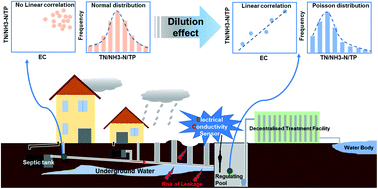Influent pollutant monitoring in decentralised treatment facilities using electrical conductivity sensors: experimental and modelling insights†
Abstract
Electrical conductivity (EC) is a common and cheap water monitoring sensor, which to some extent reflects the water body pollution level qualitatively. In this study, characteristic analysis of domestic sewage in decentralised treatment facilities located in the plain and mountainous rural areas of Eastern China showed that influent TN/NH3–N/TP concentrations were strongly and linearly correlated with influent EC values. EC source apportionment indicated that although no single ion in rural domestic sewage dominated the EC value, the EC was packed with vast amounts of information on pollutant content and could be precisely predicted using a support vector machine (SVM) regression model (R2 = 0.9063). According to field investigation and dilution simulation analysis, the mechanism of the correlations between influent TN/NH3–N/TP concentration and EC values was confirmed and attributed to the dilution caused by extraneous water during pipeline transport. Particularly, although the dilution processes in the plain and mountainous areas were similar and both the dilution coefficients were speculated to obey a Poisson distribution, the average dilution coefficient in the plain area was 0.35 ± 0.16 with λ = 4 while that in the mountainous area was 0.23 ± 0.15 with λ = 2. Our results demonstrate that the EC sensor provides a cheap, rapid and reliable alternative influent pollutant monitoring method for decentralised treatment facilities in rural areas and also show that the essential parameter to form a linear correlation is dilution.



 Please wait while we load your content...
Please wait while we load your content...